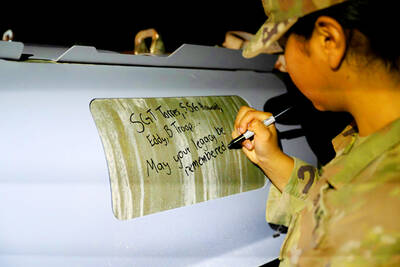It was a cataclysmic event that underscored the enormous scale and terrible randomness of space: a comet, a planet and a spectacular collision that left Jupiter nursing a dark bruise roughly the size of the Earth.
The planet is thought to have been struck by a comet or asteroid — up to 2km in diameter — that vaporized on impact, creating huge waves in the gas giant’s wispy surface.
The event only came to light when an Australian amateur astronomer noticed a dark smear on the planet’s southern hemisphere while taking photographs through a telescope in his backyard.
Anthony Wesley, 44, a computer programmer who lives in a small town outside the capital, Canberra, had been spending a quiet night stargazing on Sunday, though he admits he almost took his eye off the ball at the crucial moment.
“I’m a keen golf watcher and unfortunately we [Australia] were being hammered in the cricket,” Wesley said. “I was imaging Jupiter until about midnight and seriously thought about packing up and going back to the house to watch the golf and the cricket.”
“In the end I decided to just take a break and I went back to the house to watch Tom Watson almost make history [at the Open golf]. I came back down half an hour later and I could see this black mark had turned into view,” he said.
Wesley tipped off NASA, and images taken by the US space agency’s infrared telescope in Hawaii confirmed a scar in the atmosphere near the planet’s south pole.
Leigh Fletcher, a planetary scientist at NASA’s jet propulsion laboratory in California, received the first images from the telescope shortly after 3am on Monday.
“We saw this impact scar with our first observation. It’s the most exciting thing I’ve seen in observing these outer planets,” he said.
The images revealed an extremely bright smear on Jupiter’s surface, caused by sunlight reflecting off layers of particles and gas whipped up by the impact.
“It’s like throwing a stone into a pond. The hole vanishes very quickly, but you see this splashback of material,” Fletcher said.
The scar is expected to last for around a week before high-speed winds smear it out across the surface.
Jupiter is the biggest planet in the solar system and more than 1,300 times larger than Earth. Its outer layer is hydrogen and helium, but the interior is extremely hot and dense. Planetary scientists suspect it may even have a solid core.
The closest the planet gets to Earth is 587 million kilometers and for an impact to be visible at such distance means it must have been a cataclysmic event.
“If this had happened on Earth it would be disastrous to say the least,” Fletcher said.
Millions of meteorites pass through the Earth’s atmosphere every day. Most are small and burn up as they streak across the sky, but scientists estimate tens of thousands fall to ground each year. The risk of a larger object striking Earth is almost impossible to quantify, scientists say.
Space agencies monitor the inner solar system for bodies that may present a threat, but such objects are not tracked in the farther reaches of space.
Scientists suspect they will never know the exact size and speed of the object that collided with Jupiter because it was destroyed on impact. One theory is that the planet was hit by one of the many icy bodies that swirl around it.
NASA is investigating how to use the collision to understand more about the planet. One idea is to watch how gases churned up by the impact spread in the next few days. That could reveal details about the planet’s meteorology and the high-altitude jetstreams that separate the stripes visible on Jupiter’s surface.
The discovery was made on the 40th anniversary of the Apollo 11 moon landing and the 15th anniversary of comet Shoemaker-Levy 9 colliding with Jupiter.
Wesley recorded the discovery in his observation log: “I noticed a dark spot rotating into view in Jupiter’s south polar region [and] started to get curious,” he said. “My next thought was that it must be either a dark moon ... or a moon shadow, but it was in the wrong place and the wrong size.”
“By two o’clock I’d come back up to the house and was sending alerts to all the people I could think of that should be looking at this and especially the professional astronomers with specialized instruments for measuring this,” he said.

REVENGE: Trump said he had the support of the Syrian government for the strikes, which took place in response to an Islamic State attack on US soldiers last week The US launched large-scale airstrikes on more than 70 targets across Syria, the Pentagon said on Friday, fulfilling US President Donald Trump’s vow to strike back after the killing of two US soldiers. “This is not the beginning of a war — it is a declaration of vengeance,” US Secretary of Defense Pete Hegseth wrote on social media. “Today, we hunted and we killed our enemies. Lots of them. And we will continue.” The US Central Command said that fighter jets, attack helicopters and artillery targeted ISIS infrastructure and weapon sites. “All terrorists who are evil enough to attack Americans are hereby warned

Seven wild Asiatic elephants were killed and a calf was injured when a high-speed passenger train collided with a herd crossing the tracks in India’s northeastern state of Assam early yesterday, local authorities said. The train driver spotted the herd of about 100 elephants and used the emergency brakes, but the train still hit some of the animals, Indian Railways spokesman Kapinjal Kishore Sharma told reporters. Five train coaches and the engine derailed following the impact, but there were no human casualties, Sharma said. Veterinarians carried out autopsies on the dead elephants, which were to be buried later in the day. The accident site

RUSHED: The US pushed for the October deal to be ready for a ceremony with Trump, but sometimes it takes time to create an agreement that can hold, a Thai official said Defense officials from Thailand and Cambodia are to meet tomorrow to discuss the possibility of resuming a ceasefire between the two countries, Thailand’s top diplomat said yesterday, as border fighting entered a third week. A ceasefire agreement in October was rushed to ensure it could be witnessed by US President Donald Trump and lacked sufficient details to ensure the deal to end the armed conflict would hold, Thai Minister of Foreign Affairs Sihasak Phuangketkeow said after an ASEAN foreign ministers’ meeting in Kuala Lumpur. The two countries agreed to hold talks using their General Border Committee, an established bilateral mechanism, with Thailand

‘POLITICAL LOYALTY’: The move breaks with decades of precedent among US administrations, which have tended to leave career ambassadors in their posts US President Donald Trump’s administration has ordered dozens of US ambassadors to step down, people familiar with the matter said, a precedent-breaking recall that would leave embassies abroad without US Senate-confirmed leadership. The envoys, career diplomats who were almost all named to their jobs under former US president Joe Biden, were told over the phone in the past few days they needed to depart in the next few weeks, the people said. They would not be fired, but finding new roles would be a challenge given that many are far along in their careers and opportunities for senior diplomats can